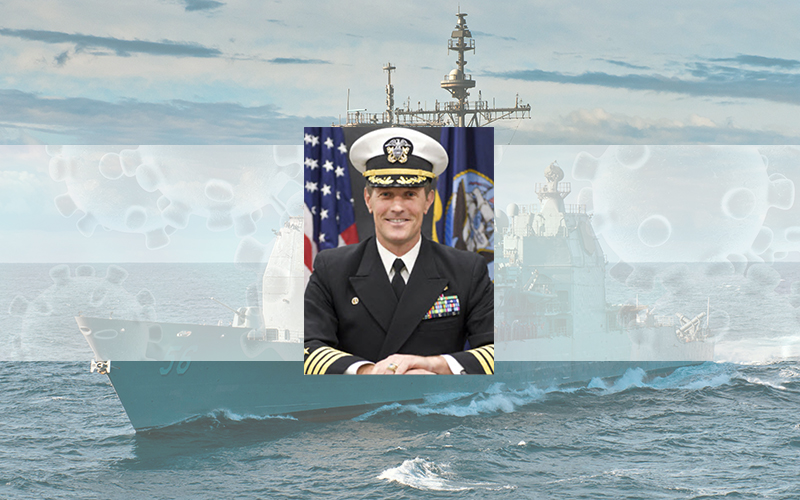On January 17, 2020, a fleet of U.S. Navy warships known as the Eisenhower carrier strike group set out for the Arabian sea, not knowing it was bound to break a Navy record. As the coronavirus pandemic spread across the globe, the fleet was ordered to avoid all port visits and has been at sea for the past 190 days, breaking the Navy’s previous record of consecutive-sea-days, 160 days.
Edward Crossman of Fayston is captain of support cruiser USS San Jacinto, a ship that acts as the main carrier’s defense. Before going to a military academy in eighth grade, Crossman attended Fayston Elementary School. Today, his parents live in Warren.
“I’ve got 400 people on the ship. My main mission is to support the carrier. I’m the carrier’s defense and the air warfare commander. I’m in charge of anything flying in the Persian Gulf,” said Crossman. The rest of the fleet includes the main carrier, USS Eisenhower, which holds about 5,000 people, and three destroyers, which hold about 300 people each.
“We jokingly call ourselves the last ship,” said Crossman when asked how long he expects to stay at sea. “We’ve been in an absolute bubble.”
TYPICAL DEPLOYMENT
A typical Navy deployment lasts seven to 10 months, but normally a fleet has multiple opportunities to stop at ports to resupply, get parts and materials, do maintenance and give sailors a break. However, as Crossman pointed out, the order to stay at sea has introduced new challenges to the fleet.
“It takes a lot of planning for the team. Normally when you pull to port, you can shut everything down and work on stuff. So now they really have to coordinate back and forth what they’re shutting down, what they’re keeping on, what they’re working on,” said Crossman.
As for resupplying goods, the fleet now relies on supply ships that transfer goods using an advanced and dangerous maneuver. “Imagine driving on the highway at 50 miles an hour and reaching out and holding hands with the driver of the other car and trying to hold that for about three or four hours,” said Crossman as a metaphor for linking his ship up to the supply ship at sea.
“As they’re moving through the water, I drive right up close to them. We shoot lines across to each other, huge span wires, and we basically link up. They’ve got a huge fueling rig. We put the probe in and transfer 3,000 gallons a minute. My tanks hold about 600,000 gallons of fuel. All this is all done while moving,” said Crossman.
AND AMAZON
In order to keep the ships aligned, Crossman and his team must make half-degree rudder changes. They must be precise; Crossman’s ship weighs about 10,000 tons, while the the supply ship weighs 50,000 tons. “That’s where a lot of accidents happen. It can be very dangerous. That’s what makes the U.S. Navy one of the strongest navies in the world, its logistics capability, and capability to continue to stay at sea and supply food, supplies, materials and fuel. And Amazon, by the way,” he said.
Yes, Crossman’s crew loves Amazon. Out of the 100 huge pallets of material transferred to the ship with each resupply, about 15 of those pallets are Amazon orders for the crew. “No joke,” said Crossman.
With no more port breaks, the crew has devised new ways to relax on the ship. Occasionally the USS San Jacinto hosts “steel beach picnics,” or parties out on the flight deck. At steel beach picnics, the crew puts out the grills, puts on the music, and plays some basketball. “And hopefully they don’t bounce the basketballs off the side and lose them, but that’s another issue,” said Crossman with a laugh.
According to Crossman, crew members have not felt the itch of quarantine boredom quite yet, because, apart from the occasional picnic, they are too busy. “They are busy as hell out here,” said Crossman. “These guys have not had cabin fever yet. They work so hard.” Around the clock, crew members are on watch, doing air control, doing drills, managing operations and attending maintenance meetings.
Crossman admitted that the crew members sometimes feel overwhelmed by the workload. “Deployment gets long and routine. You get up in the morning, you’re watching out for a threat, your making reports. Sometimes they want a break.”






